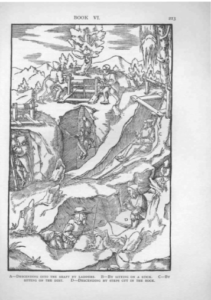The Curse of the Kobolds
Mining in the Harz Mountains of Germany has been done since medieval times. The miners of that era believed that the rock was inhabited by small elusive beings they called kobolds, who possessed a mix of human-like personalities. If a miner’s candle went out, a kobold had probably sneaked up behind him and blew it out. If his lunch went missing, a kobold must have eaten it. And if a piece of roof rock dropped and killed someone, there was probably a vindictive kobold who lived in the vicinity and didn’t want the intrusion. There were rituals to appease them, but if they got nasty, the miners would refuse to work there.
In certain shafts the kobolds played a frustrating trick, allowing the mining to proceed unimpeded. But when carted to the smelter, the ore wouldn’t melt and yield its metals. These loads were obviously cursed by the kobolds and so were dug back out of the furnace and dumped nearby. Over the years, these piles would gradually grow pink or blue stains, which everyone could point to as evidence that the kobolds had put something different in that ore, because good ore piled nearby didn’t stain.
But alchemy from the Middle Ages was evolving toward modern chemistry and early chemists wondered what the blue and pink stuff was. It took centuries but eventually it was found that at very high temperatures and in a strongly reducing environment, the cursed ore would yield a new metal. Translated into English, the kobolds contaminant became the element cobalt.
Steel is an alloy of iron and carbon, and when small amounts of cobalt are added to the mix, the steel becomes tougher and more durable. Today cobalt alloys are used in everything from the mundane, like shovel blades, to the exotic, like rocket engines bound for distant planets.
But there are things more important than steel, and yet we hardly notice them. The vitamin B12 molecule, very necessary for our well-being, contains a cobalt atom in its center. In fact it is officially called cobalamins, which is a contraction from cobalt amines, referring to proteins containing cobalt.
We omnivores get our vitamin B12 from meat protein, where cobalt has been combined with protein on its way up the food chain from soils to plants to animals to us (vegans and their breast-fed babies develop vitamin B12 deficiencies if without supplements.)
The upper Midwest has long been well-endowed with a trace of cobalt in our ecosystems, delivered by a series of glaciers coming from the north. From central Minnesota northward through Canada, the bedrock is a vast expanse of igneous and metamorphic rocks, which contain traces of cobalt (in some places sufficiently concentrated to mine it, as at Cobalt, Ontario.)
Interestingly, our North Country Native Americans had their own rock people, who were rather similar to the kobolds. These little folk appreciated a gift of tobacco and some kind words sprinkled on their rocky home, and if you really wanted a favor from them you left some little pieces of native copper, or even a copper trinket, for them. These were the Maymaygwayshi people, who could warp in and out of solid rock at their leisure.
Their gift to us includes cobalt, delivered by the glaciers to our ecosystems and readily available if we eat locally. These linkages are just another example of how intimately we are connected to the land, whether or not our culture acknowledges it.
Tags: cobalt, De Re Metallica, Lon Drake


